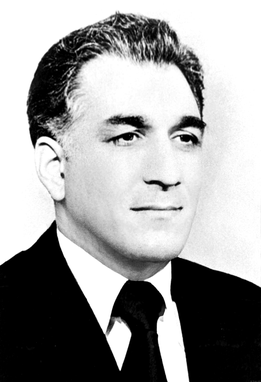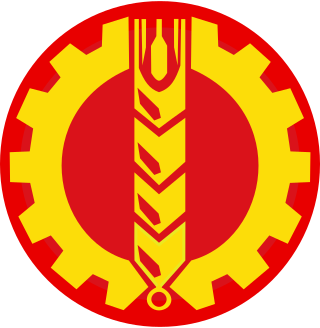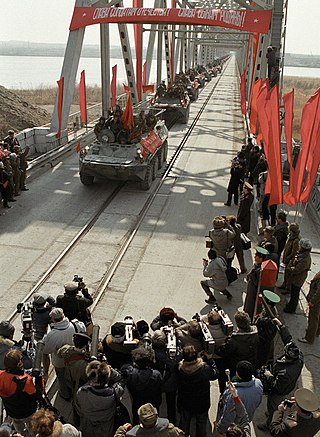This article needs additional citations for verification .(December 2023) |
| |||||
| Decades: | |||||
|---|---|---|---|---|---|
| See also: | Other events of 1986 List of years in Afghanistan | ||||
The following lists events that happened during 1986 in Afghanistan .
This article needs additional citations for verification .(December 2023) |
| |||||
| Decades: | |||||
|---|---|---|---|---|---|
| See also: | Other events of 1986 List of years in Afghanistan | ||||
The following lists events that happened during 1986 in Afghanistan .
Soviet general secretary Mikhail Gorbachev announces that soviet troops will be withdrawn from Afghanistan by the end of 1988. [1] The withdrawal of troops begins on October 15. Gorbachev's offer is made from Siberia and is part of a much wider Soviet initiative in Asia. The withdrawal brings sharp reactions: the U.S. dismisses it as "inadequate" and suggests it is no more than a normal rotation of troops; Afghan resistance groups reject it as a "bluff," while Pakistan sees it as a small but positive move. Strategic analysts say the withdrawal has no military significance since three of the six units are air-defense regiments and the Afghan resistance has no air capability. The regiments constitute only a little over 6% of an estimated 120,000 Soviet troops in Afghanistan. The war continues unabated, with many clashes between Soviet-backed Afghan troops and the resistance. Claims of success are made by both sides, but they are impossible to verify. A number of major offensives are launched during the year. Toward the end of 1986, the resistance fighters begin to receive more and better weapons from the outside world - particularly from the United States, the United Kingdom, and China - via Pakistan, the most important of these being shoulder-fired ground-to-air missiles. The Soviet and Afghan air forces then begin to suffer considerable casualties.
A report by the U.S. State Department states that the war has resulted in "one of the greatest mass migrations in history" and that Kabul's population has more than doubled to two million. "More than five million have been uprooted, nearly four million of them becoming refugees abroad ... In large areas of the countryside where resistance is active, wartime conditions and longstanding animosities among competing tribal groups have led to multiple taxation, arbitrary detention, and outright banditry." The resistance shoots down several military aircraft in Herat province; the reported death toll is 200.
700 resistance fighters are killed in Paktia province.
Karmal resigns as general secretary of the PDPA, retaining the less important position of Chairman of the Revolutionary Council. The resignation is officially attributed to reasons of health - he has made no public appearance since March 30 and is reported to have been in the U.S.S.R. for medical treatment. It is widely thought[ who? ], however, that the Soviet leadership is dissatisfied with his performance and wants to create a broader power base. His successor, new general secretary Mohammad Najibullah, was formerly head of Khad, the country's secret police, and more recently took charge of security.
Government troops clash with resistance soldiers in Badakhshan province, leaving 200 Soviet-Afghan soldiers and "dozens" of resistance soldiers dead. Also in July 120 government troops died during an ambush on a military convoy in Zabol province.
A massive explosion destroys an ammunition dump in the headquarters of the Afghan Army's 8th Division near Kabul, reportedly killing up to 100 people.
For the fifth consecutive year, UN-sponsored talks are held in Geneva between Afghanistan and Pakistan with the object of ending the military presence in Kabul. None of the meetings produce any concrete results, though differences between the two countries have narrowed since the talks began in 1982. Discussions continue through diplomatic channels, and in December a UN spokesman announces that agreement has been reached on the monitoring of Soviet troop withdrawals. The remaining stumbling block is the timetable for a total withdrawal, with Pakistan insisting that this should take place as soon as technically feasible.
A national reconciliation campaign is approved by the Politburo, including a unilateral six-month cease-fire to begin on January 15, 1987, but it meets with little response inside Afghanistan and is rejected by resistance leaders in Pakistan.
A UN human rights report reports that 10,000 to 12,000 Afghan civilians have been killed in the previous nine months by Soviet and Afghan government forces, and that children have been killed by the indiscriminate use of explosives disguised as toys. The "continuation of the military solution," the report says, "will lead to a situation approaching genocide." The same month the UN General Assembly passes a resolution, by a vote of 122 to 20, calling for a negotiated settlement to the war. Karmal resigns from the largely ceremonial post of Chairman of the Revolutionary Council. He is succeeded on November 24 by Haji Mohammad Chamkani, formerly first vice-chairman and a non-PDPA member.
An extraordinary plenum of the PDPA Central Committee approves a policy of national reconciliation, involving negotiations with opposition groups, and the proposed formation of a coalition government of national unity. A cabinet reshuffle sees the elevation of Najibullah supporters Abdul Wakil and Mohammad Rafi to the posts of foreign minister and defense minister, respectively. Najibullah visits the U.S.S.R. to discuss prospects for ending the conflict in Afghanistan.

Babrak Karmal was an Afghan communist revolutionary and politician who was the leader of Afghanistan, serving in the post of general secretary of the People's Democratic Party of Afghanistan from 1979 to 1986.

Hafizullah Amin was an Afghan communist head of state, who served from September 1979 until his assassination. He organized the Saur Revolution of 1978 and co-founded the Democratic Republic of Afghanistan (DRA), ruling Afghanistan as General Secretary of the People's Democratic Party.

Mohammad Najibullah Ahmadzai, commonly known as Dr. Najib, was an Afghan politician who served as the General Secretary of the People's Democratic Party of Afghanistan, the leader of the one-party ruling Republic of Afghanistan from 1986 to 1992 and as well as the President of Afghanistan from 1987 until his resignation in April 1992, shortly after which the mujahideen took over Kabul. After a failed attempt to flee to India, Najibullah remained in Kabul. He lived in the United Nations headquarters until his assassination during the Taliban's capture of Kabul.

The Democratic Republic of Afghanistan (DRA), renamed the Republic of Afghanistan in 1987, was the Afghan state during the one-party rule of the People's Democratic Party of Afghanistan (PDPA) from 1978 to 1992. It relied heavily on assistance from the Soviet Union for most of its existence, especially during the Soviet–Afghan War.

The People's Democratic Party of Afghanistan (PDPA) was a Marxist–Leninist political party in Afghanistan established on 1 January 1965. Four members of the party won seats in the 1965 Afghan parliamentary election, reduced to two seats in 1969, albeit both before parties were fully legal. For most of its existence, the party was split between the hardline Khalq and moderate Parcham factions, each of which claimed to represent the "true" PDPA.
The following lists events that happened during 1981 in Afghanistan.

Nur Muhammad Taraki was an Afghan revolutionary communist politician, journalist and writer. He was a founding member of the People's Democratic Party of Afghanistan (PDPA) who served as its General Secretary from 1965 to 1979 and Chairman of the Revolutionary Council from 1978 to 1979.

Khalq was a faction of the People's Democratic Party of Afghanistan (PDPA). Its historical de facto leaders were Nur Muhammad Taraki (1967–1979), Hafizullah Amin (1979) and Sayed Mohammad Gulabzoy (1979–1990). It was also the name of the leftist newspaper produced by the same movement. The Khalq wing was formed in 1967 after the split of the party due to bitter resentment with the rival Parcham faction which had a differing revolutionary strategy.

Colonel General Abdul Kadir Dagarwal was an Afghan politician, diplomat, and a military officer in the Afghan Air Force who participated in the coup d'état that created the Republic of Afghanistan under the President Dawood Khan, and later directed the Afghan Air Force and Army Air Corps squadrons that attacked the Radio-TV station during the Saur Revolution.
The following lists events that happened during 1979 in Afghanistan.
The following lists events that happened during 1980 in Afghanistan.
The following lists events that happened during 1982 in Afghanistan.
The following lists events that happened during 1983 in Afghanistan.
The following lists events that happened during 1984 in Afghanistan.
The following lists events that happened during 1985 in Afghanistan.
The following lists events that happened during 1987 in Afghanistan.

The final and complete withdrawal of the Soviet 40th Army from Afghanistan began on 15 May 1988 and ended on 15 February 1989, under the leadership of Colonel-General Boris Gromov. The Soviet military had been one of the main combatants in the Soviet–Afghan War since its beginning in 1979.

The Democratic Republic of Afghanistan was the government of Afghanistan between 1978 and 1992. It was recognised diplomatically by only eight countries which were allies of the Soviet Union. It was ideologically close to and economically and militarily dependent on the Soviet Union, and was a major belligerent of the Afghan Civil War.

The Revolutionary Council of the People's Democratic Party of Afghanistan (PDPA) ruled the Democratic Republic of Afghanistan from 1978 until its collapse in 1992. The council was the supreme state power under the communist regime and was a carbon copy of the Supreme Soviet in the Soviet Union. The point with the council was to convene on a semiannual basis to approve decisions made by the presidium.

National Reconciliation is the term used for establishment of so-called 'national unity' in countries beset with political problems. In Afghanistan the People's Democratic Party of Afghanistan government under Babrak Karmal issued a ten-point reconciliation program in 1985 upon the advice of Soviet leadership, called the National Reconciliation Policy or NRP.